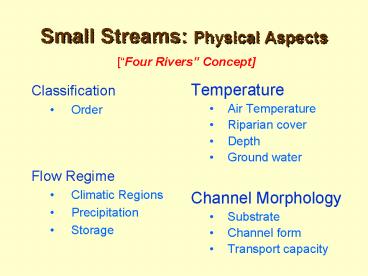Small Streams: Physical Aspects - PowerPoint PPT Presentation
1 / 26
Title:
Small Streams: Physical Aspects
Description:
Small Streams: Physical Aspects. Classification. Order. Flow Regime ... The Four Rivers Concept (Robert Naiman) Stream Flow. Hyporheic Flow ... Baker ... – PowerPoint PPT presentation
Number of Views:59
Avg rating:3.0/5.0
Title: Small Streams: Physical Aspects
1
Small Streams Physical Aspects
Four Rivers Concept
- Classification
- Order
- Flow Regime
- Climatic Regions
- Precipitation
- Storage
- Temperature
- Air Temperature
- Riparian cover
- Depth
- Ground water
- Channel Morphology
- Substrate
- Channel form
- Transport capacity
2
The Four Rivers Concept (Robert Naiman)
- Stream Flow
- Hyporheic Flow
- Gravel
- Wood
Consider Sources, Transport, Storage,
Ecological Role
3
Classification
- Stream Order
1.Small tributaries 2. 3. 4. Large rivers
Image source http//www.uwm.edu/ehlinger/physic
al.htm
4
(No Transcript)
5
Classification
- First Second order
- 1st initial, undivided streams small if any
fish populations - 2nd formed by joining of 2 first order streams
- Together 85 of streams in U.S.
- Little groundwater capacity may be ephemeral
- Large woody debris (LWD) in up to 50 of channel
- Active erosion little deposition
- Often riparian shades entire stream
- Gradient gt 10 stair-step, falls, riffles
- Elevation - high
Image source http//www.parksonline.org/parks/oly
mpic/mikeburke/
6
Classification
- Third Fourth Order
- 3rd order formed by joining of 2nd order streams,
etc. - Gradient lt5 some falls, rapids
- LWD lt25 of channel
- Variable riparian cover
- High sediment transportation and deposition
- Often high fish production
Cheniga Stream, Price William Sound, AK Image
source UW Freshwater Marine Image Bank
7
Classification
- Fifth Order and Greater Rivers
- Less influence of riparian zone less canopy
- Lower gradient more deposition
- Thermal regime more stable
Columbia River
8
Classification
Stream order, mileage, and use by anadromous fish
in a typical coastal watershed East Fork
Winchuck River, OR
9
Flow Regime
- Coastal Systems
- 1. High levels of precipitation
- mostly as rain
- mostly Oct- April
- 2. Small watersheds relative to stream size
- Interior Systems
- 1. Low levels of precipitation
- rain in early summer
- snow in winter
- 2. Large watersheds relative to stream size
10
Flow Regime
- Coastal vs. Interior
- Two typical annual streamflow patterns (note
change of scale)
11
Flow Regime
- Example of how precipitation affects flow timing
12
Flow RegimeStorage
- Low vs. High density drainage discharge
13
Flow Regime
- Precipitation Zones
1. Highland (gt 1500 m)
2. Snow Dominated (1200 1500 m)
Upper limit
Significant Rain-on-Snow Zone
3. Rain on Snow (300 1200 m)
Lower limit
4. Rain Dominated (200 300 m)
5. Lowland (lt 200 m)
Mt. Baker
14
Hyporheic flow
- Hyporheic flow is the vertical and lateral flow
of a stream through sediment interstices (Jones
and Holmes 1996).
Under the rocks and stones there is water
undergroundOnce in a lifetime Talking Heads
Depending on the residence time of the water in
the ground, it may differ greatly from surface
water in temperature and dissolved oxygen.
Image source http//www.fish.washington.edu/natur
emapping/water/1fldhypo.html
15
Temperature
- Stream Temperature
- Governed by
- Local air temperature
- water tracks air temperature but lags behind it
- Depth
- deep water warms and cools more slowly than
shallow - Riparian Cover
- canopy affects both the average temperature and
the amplitude of change because of effects on
local air temperature, exposure to solar
radiation, and heat loss
16
Temperature
- Stream Heating
17
Temperature
- Stream temperature tracks air temperature but is
insulated by depth
18
Hyporheic water temperature
- What controls ground water temperature?
- If you dig a well, how cold will the water be?
19
Temperature
- Groundwater Temperature
- Governed by local air temperature
- Influence by air declines with depth
- neutral zone reached when groundwater temp is
constant - Therefore groundwater is cool in summer and
warm in winter, relative to the adjacent stream.
20
Temperature
- Ground water approximates the mean annual air
temperature
Approximate temperature (C) of groundwater in the
United States at 10-20 m (from Todd 1980 after
Collins 1925 see also Geraghty et al. 1973).
21
Channel Morphology
- Factors determining channel morphology
Channel Form Origin, confinement, gradient
Substrate Size, volume and frequency of Large
Woody Debris and Sediment input
Transport Capacity Frequency, magnitude, and
duration of flow
- Channel Morphology
- Width
- Depth
- Bed slope
- Grain size
- Bedforms
- Sinuosity
- Scour depth
Independent Variables
Dependent Variables
22
Channel Morphology
initiation
scour
deposition
Large Woody Debris
LWD immobile traps sediment
LWD mobile acts as sediment
cascade
step-pool
plane-bed
pool-riffle
regime
Source Transport Response
23
Channel Morphology
- Channel Confinement
- Constrained valley form
- High gradient
- Unstable substrate and channel complexity
- Broad valley
- low gradient
- More stable substrate and channel complexity
Image source www.scalloway.org.uk
24
Channel Morphology
- Habitat Units
- Pools
- plunge (vertical drop), flows accelerating
- scour (lateral), flows accelerating
- dammed (above dam), flow decelerate
- Glide
- Riffle
25
Small StreamsPhysical Aspects
- The delivery and routing of water, sediment, and
woody debris to streams are the key processes
regulating the vitality of watersheds and their
drainage networks in the Pacific Northwest
coastal ecoregion. - - Naiman et al. 1992
26
What about other factors?
Chemistry of the stream can play a large role in
primary production. Specifically, Nitrogen or
Phosphorous often limit algal growth. In
general, a ratio of about 161 optimizes algal
growth. In the basalt geology of the western
Oregon Cascades, the NP ratio in stream water is
about 5-101. In contrast, granite dominated
geology on western Vancouver Island showed an NP
ratio well over 201. Thus in the Oregon
streams, Nitrogen seemed to be limiting whereas
in Carnation Creek it was Phosphorous.































